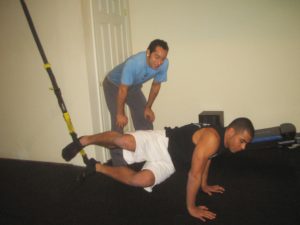Kids & Teens
top kids’ food trends
Marketing experts who studied current food trends among children say that “natural” foods are “here to stay” and that kids today have become more independent in their food choices. According to the market research organization Mintel, there has been “a huge amount of activity” in terms of foods being promoted directly to kids; this is particularly true in terms of the candy and soda products that are now available to children. A senior analyst at Mintel reported these other notable food trends affecting kids:
IDEA Member Combines Education, Fitness
When many schools nationwide are reducing or eliminating physical education, one Alpine, California, school is making fitness a priority. IDEA member Marc McKellar and his wife, Cara, have developed a partnership to improve activity levels among students at the Day-McKellar Preparatory School. He runs the Peak Athletic Center, and she runs the school; both are located within the same building. “We provide 60 minutes of physical education per day [to students] in an indoor soccer arena and gym,” says Marc. The school serves students from kindergarten to high-school seniors.
National Wildlife Federation Urges Outdoor Activity
The National Wildlife Federation (NWF) wants your kids to go take a hike. On February 3, the NWF launched the Be Out There campaign, an initiative designed to encourage families…
Peers Influence Teen Girls’ Weight Loss Goals
It is suggested that some people, in their efforts to lose weight, emulate celebrities and magazine cover models. When it comes to teen girls’ motivations for shedding excess pounds, that…
Michelle Obama Tackles Childhood Obesity
First Lady Michelle Obama wants to change
the way U.S. children eat and play. Disturbed by childhood obesity rates, she has enlisted the help of the White House to launch the Let’s Move campaign. According to a press release, she has gathered support from people in government, medicine, science, business, education and athletics to overcome the childhood overweight/obesity problem. For example, several school lunch suppliers have agreed to
reduce the fat, sugar and salt content of their meals over the next
5 years.
Sports Participation in Youth Holds Long-Term Benefits for Women
Research has indicated that sports participation promotes positive behaviors in girls. But are there long-term benefits that continue once the jerseys have been retired? According to a study developed by the National Board of Economic Research, the answer is yes.
delaying solid foods can cause allergies
It seems that more kids are being diagnosed with allergies these days, and this may be the result of how old the children were when they were introduced to solid foods, according to a recent study published in the January issue of Pediatrics.
PE classes in low-income areas
According to a study published in the Archives of Pediatrics & Adolescent Medicine (November 2009), physical education (PE) classes can make a real difference in the weight status of teens who live in low-income areas. The study examined physical activity opportunities linked to fitness and weight status among adolescents enrolled in 19 public schools participating in the California Endowment’s Healthy Eating, Active Communities program.
adolescent weight loss success stories
Why can some teens lose weight and keep it off, while
others try and try again, to no avail? According to a recent study, teenagers who do lose weight appear to share certain characteristics that contribute to their success.
The cross-sectional study, published in the December 2009 issue of the Journal of the American Dietetic Association, showed that adolescents who lose weight are more likely to report using the following “healthful weight
control behaviors”:
autism & kids’ diets
Despite questionable anecdotal evidence
espoused by celebrities like Jenny McCarthy,
a panel of experts led by a Harvard Medical School researcher has determined that special diets do not improve autism in children.
Team Sports Good for Girls, Bad for Boys?
Many parents encourage their children to engage in sports to help improve physical activity levels. However, a recent study suggests that playing on a team may incite poor behavior among boys. The study was presented at the American Public Health Association’s 137th Annual Meeting & Exposition in Philadelphia. The researchers surveyed more than 13,000 U.S. high-school students on topics that included sports participation and risky behaviors. According to the results, team sports participation by boys correlated with higher rates of fighting, drinking and binge drinking.
Fun and Function for Youth
Another grim doctor’s appointment: Tim’s excessive body weight, high blood pressure and high cholesterol are a growing concern for his doctor. Tim has become a walking risk factor for heart attack, stroke and type 2 diabetes. In addition, his weight has created pain in his joints and other body structures, making it hard for him to move or exercise. He used to play sports, but as his body weight rose, movement became more difficult and painful, causing him to stop physical activity all together. Tim is in the 6th grade.
how local stores affect kids’ snacking
Childhood obesity in America is higher among ethnic minorities. One reason may be their limited access to affordable, healthy food options, according to researchers who reported their findings in the November issue of the journal Pediatrics.
The purpose of the study under review was to document the nature of children’s food purchases in “corner stores” located near their
elementary schools. This observational trial looked at kids in grades 4 through 6 who lived and attended school in low-income, high-minority neighborhoods.
sweet nothings
Increased consumption of sweetened beverages has been linked to higher energy intake and weight gain in children. Now a new study
has shown that a girl’s beverage intake at age 5 can predict her fat
composition and weight status in later childhood and adolescence.
Fit Boys Are Smarter, Says Study
Boys interested in improving report card scores may want to take up running or bicycling. A study of 1.2 million men born between 1950 and 1976 determined a link between cardiovascular fitness and “intelligence.” Researchers from the Institute of Medicine at the University of Gothenburg, in Sweden, analyzed the physical capacity, brain power and socioeconomic status of men when they reported for military duty at age 18.
vitamin D & growing bones
According to a recent study published online by the journal Pediatrics, at least 1 in 5 kids in America under the age of 11 doesn’t get enough daily vitamin D, which can have a negative effect on proper bone growth.
The problem is particularly widespread in minority groups: almost 90% of African American children and 80% of Hispanic kids may be deficient in vitamin D, the researchers estimated.
anorexia in girls affects brain function
A recent study conducted in the Canadian provinces found that adolescent girls with anorexia nervosa may suffer from lifelong brain damage and loss of cognitive function—even if they ultimately return to a normal weight later in life. Until now, little was known as to the long-term effects of this disease in female subjects with adolescent-onset anorexia nervosa.
From Playstation® Pro to Power Player
Client: Aja
Personal Trainer: Marc Coronel, owner of Open Mind Fitness
Location: Greenwich, Connecticut
Rewriting History. At 12 years of age, Aja was becoming one of the many overweight and obese children in the U.S. He preferred the PlayStation to playing outside, and the only movement he experienced was during physical education class at school. But that didn’t seem enough to combat his relative inactivity and fondness for sweets.
Wrestling, Football, Most Injurious High-School Sports
Engaging in team sports may help high-school students lead more active lifestyles. But depending on the sport, your teen may also be at greater risk for injury. Of all high-school sports, football and wrestling are the most injurious, according to recent
research. In a first-of-its-kind study, published in the
September issue of the American Journal of Sports Medicine (2009;
37 [9], 1798–1805), scientists examined severe injuries among students from 2005 to 2007.

